Orion is among the most prominent constellations in the sky. It is located on the celestial equator and it is visible throughout the world. Orion is named after a hunter from Greek mythology.
Key Facts & Summary
- The constellation of Orion is among the oldest recognized constellations in the world.
- Among the earliest known depictions of Orion lies in a prehistoric Aurignacian mammoth ivory carving dated to be between 32,000 to 38,000 years old.
- Orion is the 26th largest constellation in the sky, stretching for around 594 square degrees.
- The brightest star in Orion is Rigel – an Alpha Cygni variable blue star which has a maximum magnitude of around 0.13.
- Rigel is also, generally, the seventh-brightest star in the night sky.
- Another famous bright star that resides in Orion, is the red supergiant Betelgeuse, which is generally the ninth brightest star in the night sky.
- Betelgeuse occasionally outshines even Rigel, as it is also a variable star with an apparent magnitude varying from +0.0 to +1.13.
- There are three Messier objects located in the constellation of Orion. They are the Messier 42 and Messier 43 nebula, and the reflection nebula Messier 78.
- Around 10 stars in the constellation of Orion have been discovered to host exoplanets.
- Orion hosts numerous famous asterisms such as the Sword, Head, Club, Shield, and probably the oldest and most well-known, the Belt.
- Orion belongs to the Orion family constellations, along with Canis Major, Canis Minor, Lepus, and Monoceros.
- The constellation of Orion hosts numerous bright stars, such as Rigel, Betelgeuse, Bellatrix, Mintaka, Alnilam, Alnitak, Saiph and Meissa.
- Many famous nebulae are present in Orion, apart from the Messier objects, they are the Horsehead Nebula, Barnard’s Loop, Flame Nebula, NGC 2023, and the Monkey Head Nebula.
- A famous deep-sky object in Orion is the Orion Molecular Cloud Complex, which is comprised of a large group of dark clouds, bright emission and reflection nebulae, H II regions, and young stars.
The constellation of Orion is probably the most prominent, and amongst the oldest constellations in the night sky, hosting numerous bright stars, nebulae, clusters, and more.
The distinctive pattern of Orion is recognized in several cultures around the world, and thus many myths and legends are associated with it.
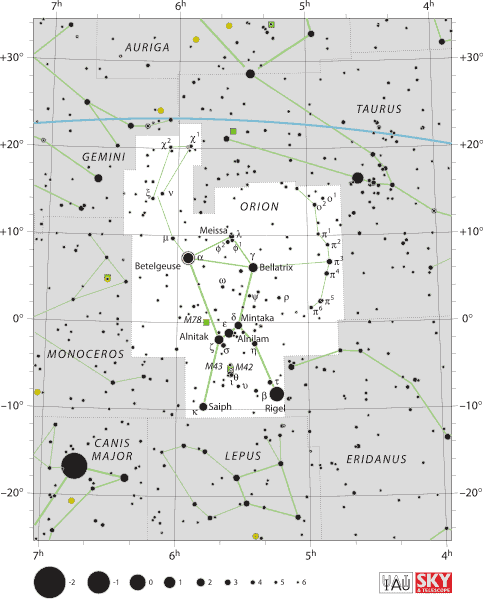
Among the earliest depictions of Orion is a prehistoric – Aurignacian – mammoth ivory carving found in a cave in the Ach valley in West Germany, in 1979.
Archaeologists estimate that this carving is between 32,000 to 38,000 years old. Other records of Orion can be found in the ancient Babylonian star catalogs of the Late Bronze Age.
Orion was called the MULSIPA.ZI.AN.NA. – the Heavenly Shepherd or the True Shepherd of Anu – Anu being the chief god of the heavenly realms.
In ancient Egypt, the stars of Orion were regarded as a god, called Sah. Since Orion rises before Sirius, the brightest star in the night sky, whose heliacal rising was the basis for the Solar Egyptian calendar, Sah was closely related to Sopdet, the goddess who personified Sirius.
What is more interesting is the fact that in Egyptian mythology, the gods descended from Sirius and the Orion’s Belt asterism. They instigated the human race.

The three pyramids on the Giza Plateau simulate the alignment of the three stars that form Orion’s Belt. The air shafts inside these pyramids point directly to the Orion constellation.
However, these aren’t the only pyramids pointing towards Orion. In Mexico, two large pyramids were discovered to point directly towards Orion’s Belt as well. They were built in the 2nd century B.C.
Location
The constellation of Orion is the 26th largest constellation in the night sky. Orion spreads out for around 594 square degrees. The constellation of Orion is easy to spot since it is among the brightest constellations. It lies on the celestial equator and it is visible throughout the world.
- Right Ascension: 5 hours
- Declination: +5 degrees
- Visible: between +85 degrees and -75 degrees
- Best viewed: at 21:00 / 9 p.m. during January
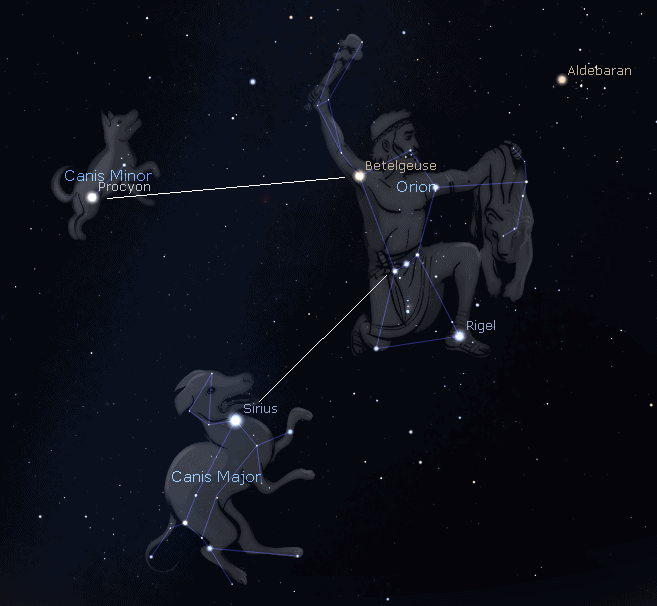
Orion is known as the hunter, being associated with one in Greek mythology. The mythical hunter, Orion, is often depicted in star maps as either facing the charge of Taurus, ( the celestial bull – zodiacal constellation ), who is pursuing the Pleiades sisters, (represented by the famous open cluster) or chasing after the hare (constellation Lepus), with his two hunting dogs, represented by the nearby constellations of Canis Major and Canis Minor.
Orion’s neighboring constellations are Eridanus (the River), Gemini (zodiacal constellation – celestial twins), Lepus (the Hare), Monoceros ( the Unicorn), and Taurus ( zodiacal constellation – celestial bull).
Messier Objects
In the constellation of Orion, there are only three Messier objects, they are Messier 42 and Messier 43, which are nebulas, and the reflection nebula Messier 78.
Messier 42
Messier 42, also designated as NGC 1976, and known as the Orion Nebula – is a diffuse reflection nebula located south of the Orion’s Belt asterism.
The Orion Nebula is among the brightest ones in the sky and can be seen without binoculars. It has a visual magnitude of 4.0, being 1,344 light-years away from Earth.

If viewed with the naked eye it appears as a slightly blurry central “star” in Orion’s Sword asterism, south of Orion’s Belt asterism. The Orion Nebula is the nearest known region of massive star formation to the Solar System. It is part of the Orion Molecular Cloud Cluster.
The Orion Nebula also contains the Trapezium or Orion Trapezium Cluster. This celestial object is a very young open cluster, recognizable by its four brightest stars, which form a trapezium-shaped asterism.
The brightest star in Orion’s Trapezium Cluster is Theta-1 Orionis C, which is a blue main-sequence star of spectral class O6pe V. Theta-1 Orionis C has an apparent magnitude of 5.13, being 1,500 light-years away from us. It is among the most luminous stars, and the star with the highest surface temperature of any visible star to the naked eye – 45,000 K – 7.7 times hotter than our Sun.
Messier 43
Messier 43, designated as NGC 1982, also known as De Mairan’s Nebula, is a star-forming emission-reflection nebula. It is part of the Orion Nebula, yet separated from it by a large lane of interstellar dust.
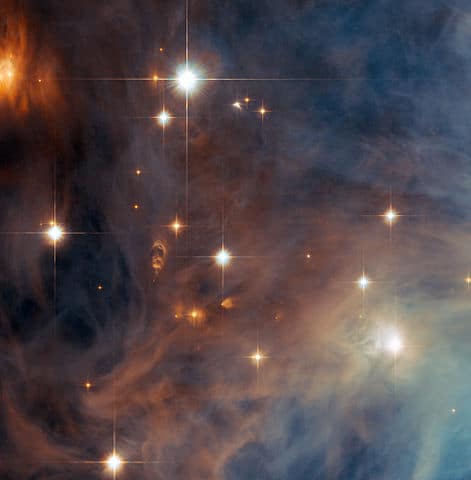
De Mairan’s Nebula has an apparent magnitude of 9.0, being 1,600 light-years away from us. The nebula is located at around seven arcminutes north of the Trapezium cluster. The H II region / star-forming region is estimated to have a diameter of around 2.1 light-years.
Messier 78
Messier 78, designated as NGC 2068, is a reflection nebula that surrounds two 10th magnitude stars and can be easily be found in a small telescope.
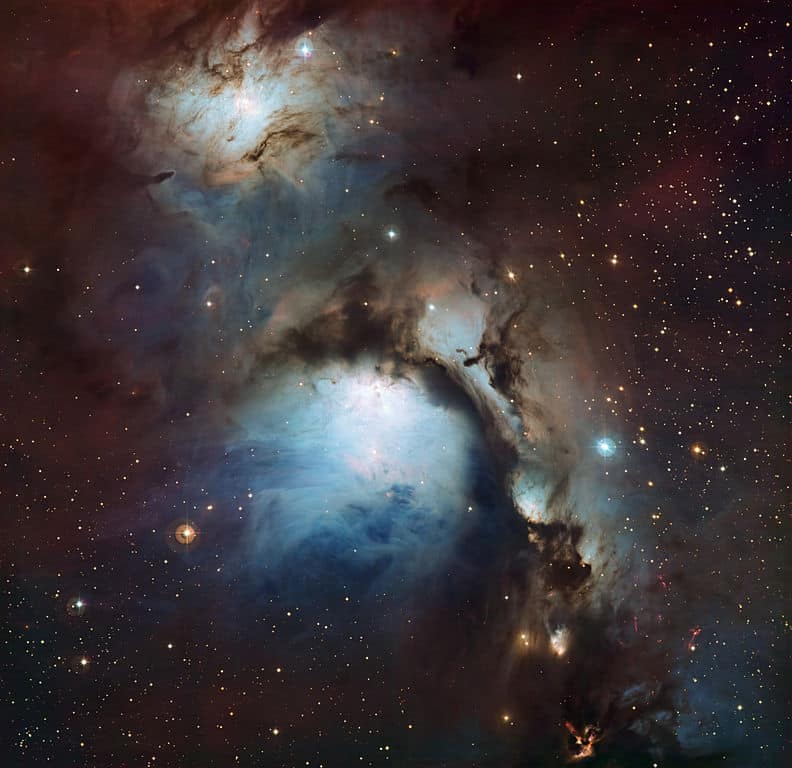
Messier 78 contains around 45 T-Tauri type variable stars – which are young stars still in the process of formation. Messier 78 is 1,350 light-years away from Earth, having an apparent magnitude of 8.3, and a radius of 5 light-years.
Notable Stars
The constellation of Orion hosts several bright stars, some of which are among the brightest in the night sky. The brightest star in Orion is Rigel, followed-up by Betelgeuse.
Rigel
Rigel, designated as Beta Orionis, is a massive blue-white supergiant variable star. Though it appears as a single star, Rigel is actually a star system, containing 4 stars. Rigel is the seventh-brightest star in the night sky.
The primary star, Rigel, is an Alpha Cygni variable star, having an apparent magnitude ranging from 0.05 to 0.18. Rigel is around 61,500 up to 363,000 times brighter than our Sun.
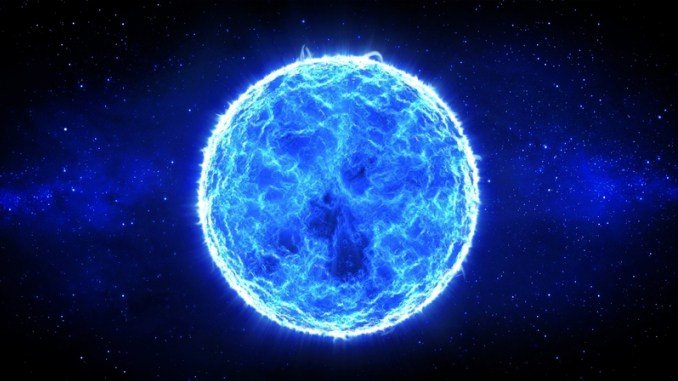
It is located at around 860 light-years away from us. Rigel has 7,000% of our Sun’s radius, and 2,100 % of our Sun’s mass. As time passes, Rigel will expand to an even greater size transcending into a red supergiant.
It may explode as a supernova one day. Rigel, along with Bellatrix, Betelgeuse, and Alnilam are the navigational stars of the Orion constellation. Though Rigel is the brightest star in Orion, it is occasionally outshone by Betelgeuse.
Betelgeuse
Betelgeuse, designated as Alpha Orionis, is the second-brightest star in Orion, occasionally outshining Rigel. Betelgeuse is a red supergiant semi-regular variable star, with an apparent magnitude varying between +0.0 and +1.13. It has the widest range of varying magnitude out of any first-magnitude star, being the ninth-brightest star in the night sky.
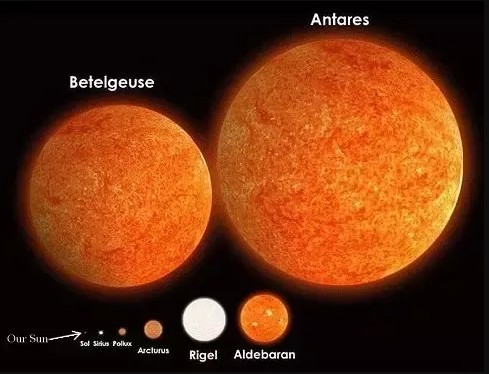
Betelgeuse is located at around 640 light-years away from Earth, and its brightness ranges from 90,000 to 150,000 times that of our Sun. Betelgeuse is among the biggest stars known to us, having a radius of around 88.700% of our Sun’s radius, and 1,160% of its mass.
Due to its size, Betelgeuse is cooler than our Sun, having average surface temperatures of around 3,500 K. The star is surrounded by an intricate envelope – nebulae – about 250 times its size. This enveloped formed around Betelegeuse from its lost mass, as Betelgeuse loses around 1 solar mass every 10,000 years.
Bellatrix
Bellatrix, designated as Gamma Orionis, is the third brightest star in Orion. Bellatrix is a slightly variable star, with a variable apparent magnitude between 1.59 and 1.64. It varies in being the 27th and the 25th brightest star in the night sky.
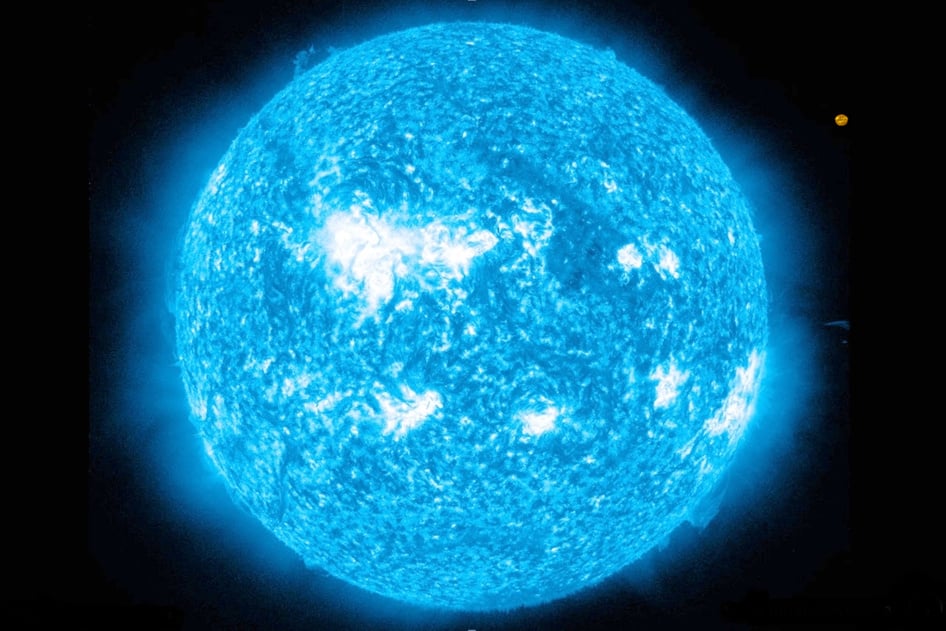
Bellatrix is a blue star located at around 250 light-years away from us. It has around 575% of our Sun’s radius, around 860% of its mass, and it is around 9.211 times brighter.
Mintaka
Mintaka, designated as Delta Orionis, is the seventh brightest star in Orion, and the 73rd brightest star in the night sky. It is among the famous three belt stars that form Orion’s Belt.
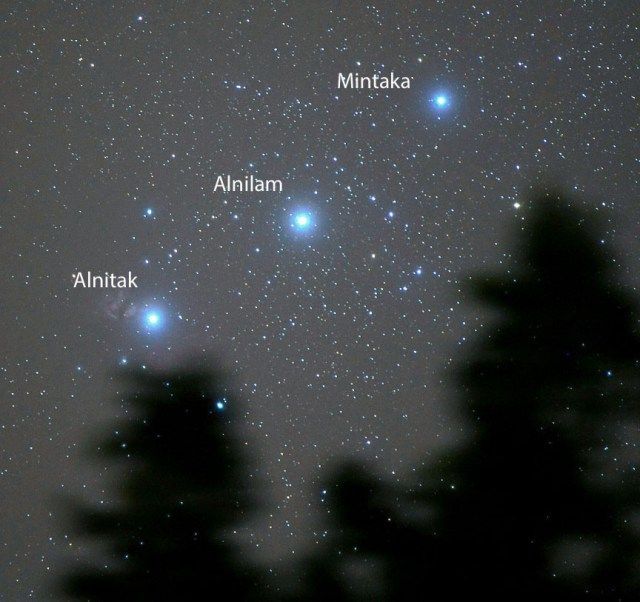
Mintaka is actually a multiple star system, rather than a single star, however, the primary component, Mintaka A, is a blue giant star, which is around 190.000 times brighter than our Sun. This star is located at around 1,200 light-years away.
Mintaka is also 5.1 times hotter – 29,500 K – and around 20 times bigger than our Sun, having around 24 solar masses, and a radius of about 16.5 times that of our Sun. It is the smallest and least massive star in Orion’s Belt.
Alnilam
Alnilam, designated as Epsilon Orionis, is the 4th brightest star in Orion, and the 29th brightest star in the night sky. Alnilam is a bright blue supergiant star, being part of the famous asterism, Orion’s Belt.
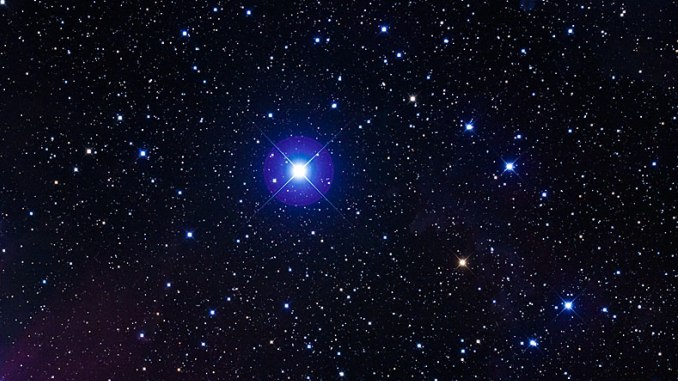
It is the biggest and most massive star of the asterism. Alnilam is an Alpha Cygni variable star, its brightness varies from magnitude 1.64 to -1.74. Alnilam is around 537,000 times brighter than our Sun, being more than 30 times bigger, and having around 4.000% of its mass.
Alnilam is located at around 1,975 light-years away from us. It illuminates a molecular cloud that surrounds it, NGC 1990. Alnilam is situated in the middle of the Orion’s Belt asterism.
Alnitak
Alnitak, designated as Zeta Orionis, is a triple star system. The primary star, Alnitak, is the 5th brightest star in Orion, and the 31st brightest star in the night sky.
Alnitak is part of the famous asterism, Orion’s Belt. It is located at around 1,260 light-years away from us. Alnitak is a blue supergiant star with an apparent magnitude of 2.0.

Alnitak is 250,000 times brighter than our Sun, having around 33 solar masses, and a radius of around 20 times that of the Sun. Alnitak is the second most massive, and the second-biggest star in Orion’s belt. It is also a fast-spinning star, having a rotational velocity of around 110 km / 68 mi per second.
Saiph
Saiph, designated as Kappa Orionis, is the sixth brightest star in Orion, and one of the four stars that comprise Orion’s main quadrangle.
Saiph is a supergiant star slightly variable star of magnitude 2.09, varying by about 0.4 magnitudes. It is a supernova candidate that will explode in the near future.
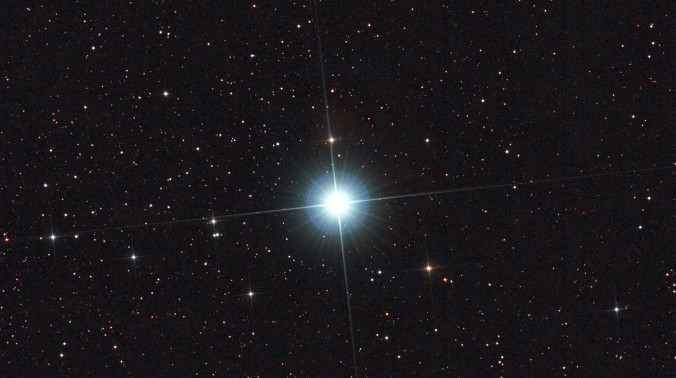
Saiph has around 15.50 solar masses, 22.2 solar radii, and it is 56,881 times brighter than our Sun. Saiph is hotter than Rigel, having average surface temperatures of around 26,500 K. It is located at around 650 light-years away from us.
Meissa
Meissa, designated as Lambda Orionis, is the eight-brightest star in Orion, having an apparent magnitude of 3.33. Meissa is a multiple star system located at around 1,100 light-years away from us.
The primary star, Meissa, is a giant star which is 165,000 times brighter than our Sun. It has around 27.9 solar masses and around 10.0 solar radii.
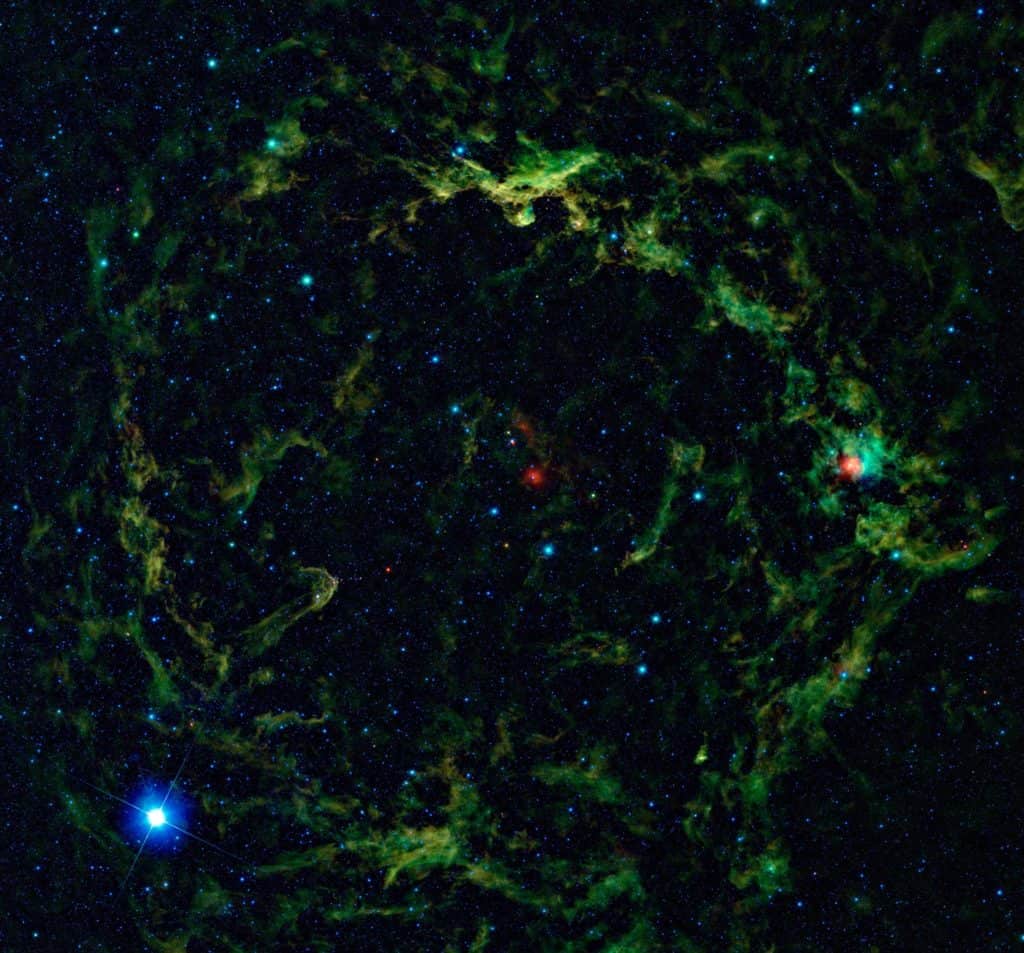
This star is the dominant member of a 5-million-year-old-star forming region known as the Collinder 69 cluster. The ultraviolet energy radiating from Meissa is creating the Sh2-264 H II region in the neighboring volume of space.
Orion Asterisms
The famous asterisms of Orion are the Belt, Sword, Head, Club, and Shield. The stars forming Orion’s Belt are Mintaka, Alnilam, and Alnitak.
Orion’s Sword contains the Orion Nebula, the Messier 43 nebula, the Running Man Nebula, and the stars Theta Orionis, Iota Orionis, and 42 Orionis.
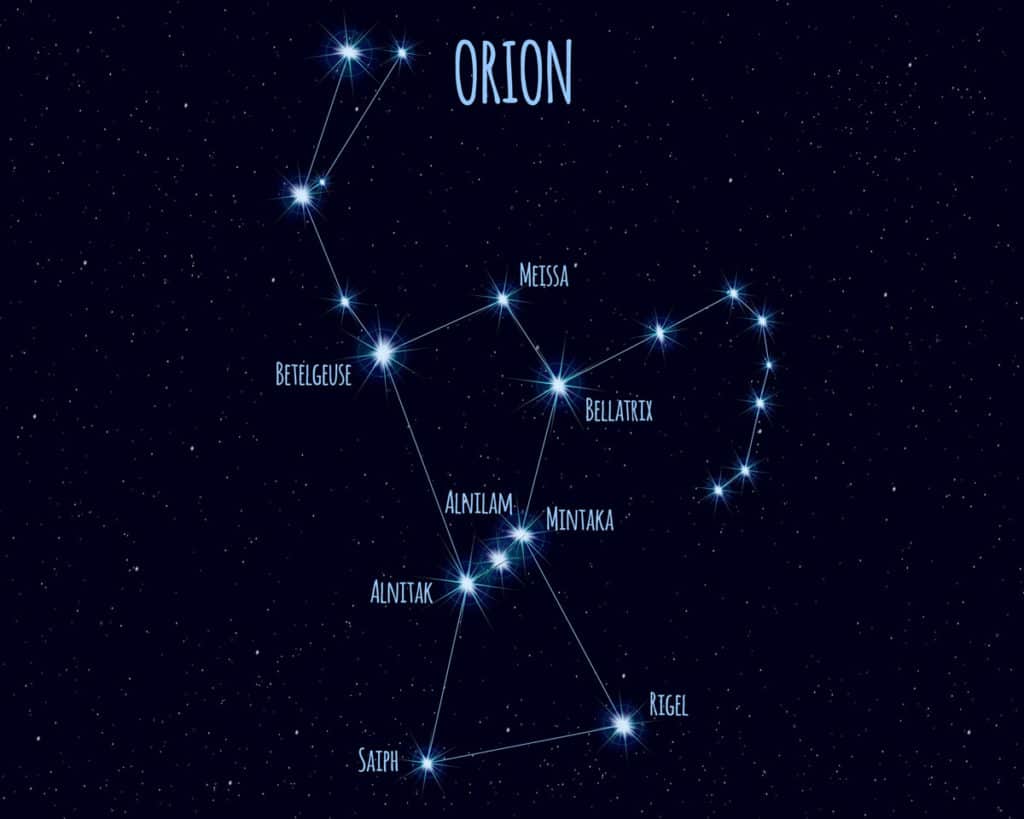
Orion’s Head is comprised out of three stars. The apex is marked by Meissa – Lambda Orionis, and Phi-1, and Phi-2 make up the base.
Orion’s Club stretches north from Betelgeuse. Mu Orionis marks the elbow, Nu and Xi mark the handle of the club, and Chi1 and Chi2 mark the end of the club. East of Chi1 is the Mira-type variable red giant star – U Orionis.
Orion’s Shield is comprised out of six stars, all of them are situated west from Bellatrix. The six stars are designated as Pi Orionis – Pi1, P2, P3, P4, P5, and P6 make up Orion’s Shield asterism.
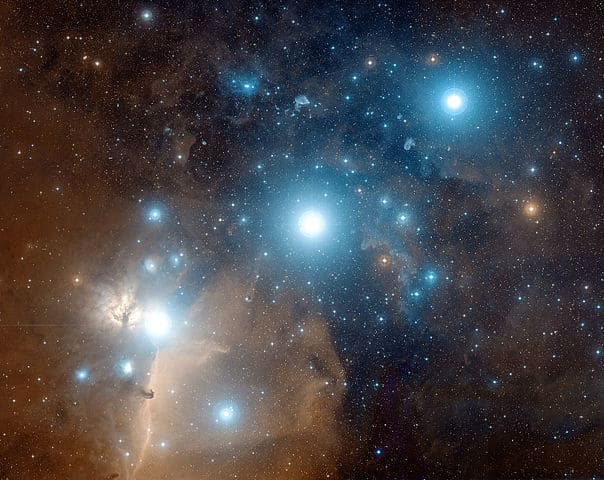
Another famous asterism is the distinctive hourglass-shaped asterism, formed by Orion’s seven brightest stars. Four stars, Rigel, Betelgeuse, Bellatrix, and Saiph, form a large roughly rectangular shape, in the center of which lie the three stars of Orion’s Belt – Alnitak, Alnilam, and Mintaka.
Navigational Aid
Orion is often used to locate other stars. An extended imaginary line from Orion’s Belt asterism southeastwards points towards Sirius, the brightest star in the sky. Northwestward, the star Aldebaran can be found, which is the brightest star in the constellation of Taurus.
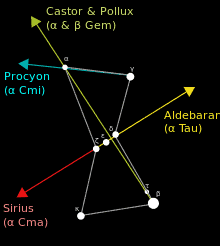
A line eastward across the two shoulders of Orion, marked by Bellatrix and Betelgeuse, indicates the direction of Procyon, the brightest star in the constellation of Canis Minor.
A line extended from Rigel through Betelgeuse points towards Castor and Pollux, the brightest stars of the Gemini constellation. Additionally, Rigel is part of the Winter Circle asterism, while Betelgeuse of the Winter Triangle asterism, marking the center of the Winer Hexagon.
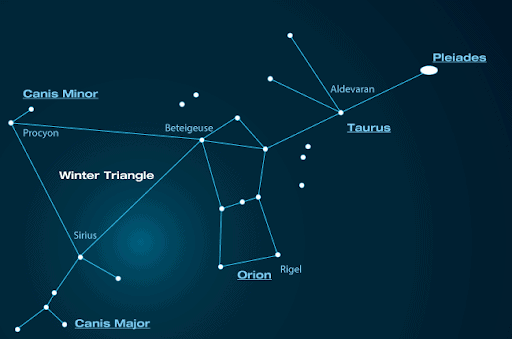
Rigel, Betelgeuse, Bellatrix, and Alnilam are the navigational stars of the Orion constellations, selected due to their brightness and since they are easily recognizable.
Other Deep-Sky Objects
Among the most common deep-sky objects in the constellation of Orion, are the nebulae. Apart from the aforementioned Messier nebulae, here are some other deep-sky objects located in Orion.
Nebulae
Probably the most well-known nebulae in Orion, are the Orion Nebula – Messier 42, De Mairan’s Nebula- Messier 43, and Messier 78. However, there are other amazing nebulae in Orion.
Horsehead Nebula
The Horsehead Nebula, also known as Barnard 33, is a dark nebula located south of Alnitak, in the bright emission nebula IC 434. The Horsehead Nebula is around 1,375 light-years away from us.
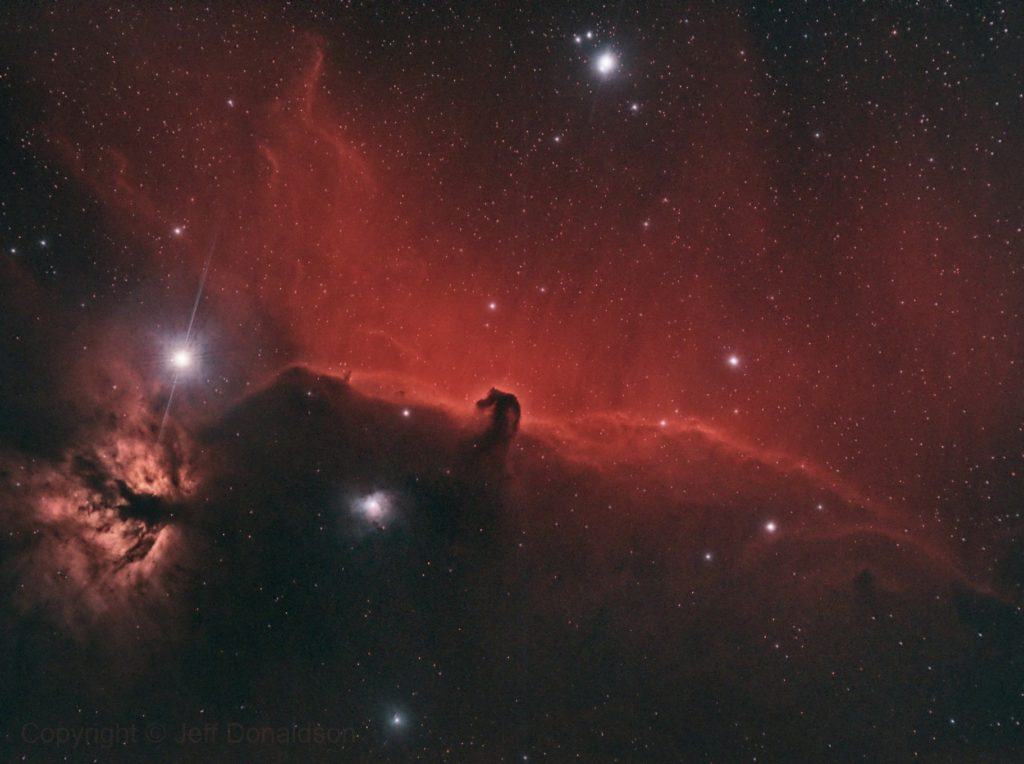
This nebula was discovered in 1888 by Williamina Fleming. The nebula got its name due to the shape of its dark dust clouds and gases, resembling the head of a horse. It is part of the Orion Molecular Cloud Complex.
Barnard’s Loop
Barnard’s Loop is an emission nebula located in the Orion Molecular Cloud Complex. It has an apparent magnitude of 5, and it is around 1,600 light-years away from us.
Some theorize that the nebula formed in a supernova explosion around 2 million years ago. It is named after E.E. Barnard, the astrophotographer who photographed the nebula and published a description in 1894.
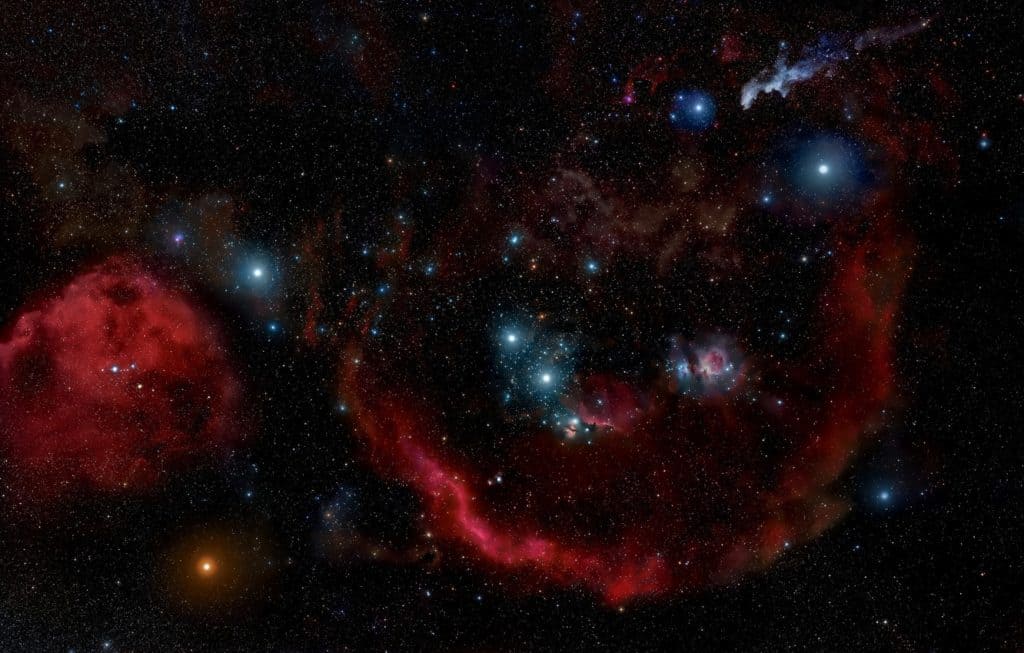
The Barnard’s Loop nebula is around 150 light-years in radius, covering much of the constellation of Orion. It appears as a large arc centered on Messier 42. The loop is believed to be ionized by the stars located in the Orion Nebula.
The Flame Nebula
The Flame Nebula is an emission nebula located at around 1,300 light-years away from us. It has an apparent magnitude of 2.0, and it is illuminated by the hot blue supergiant Alnitak.
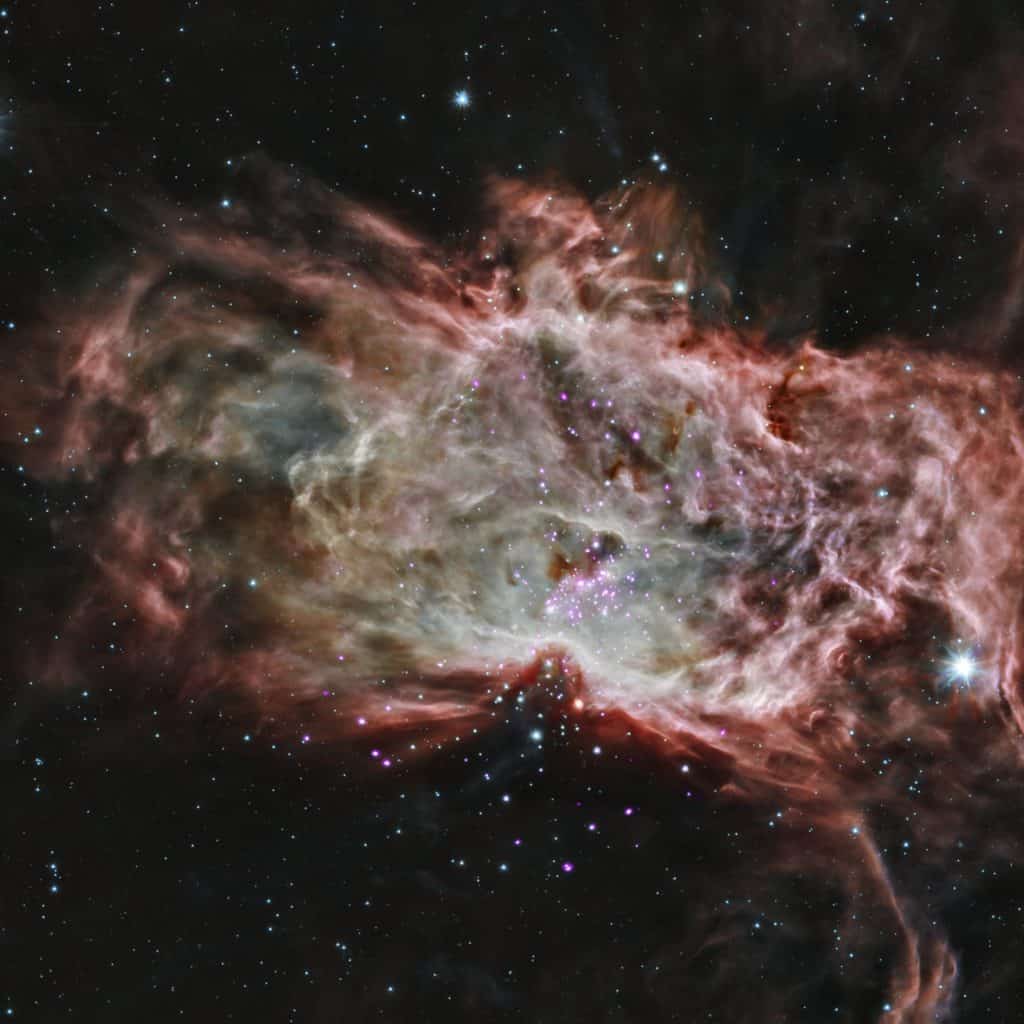
Alnitak emits ultraviolet light into the nebula, knocking electrons from the hydrogen gas clouds inside the nebula, and the glow of the nebula is the result of the electrons and ionized hydrogen recombining. The Flame Nebula also resides within the Orion Molecular Cloud Complex.
NGC 2023
NGC 2023 is a reflection nebula and it is among the brightest sources of fluorescent molecular hydrogen. It is lit by the B star HD 37903. NGC 2023 is among the largest reflection nebulae in the sky, having 4 light-years in diameter.
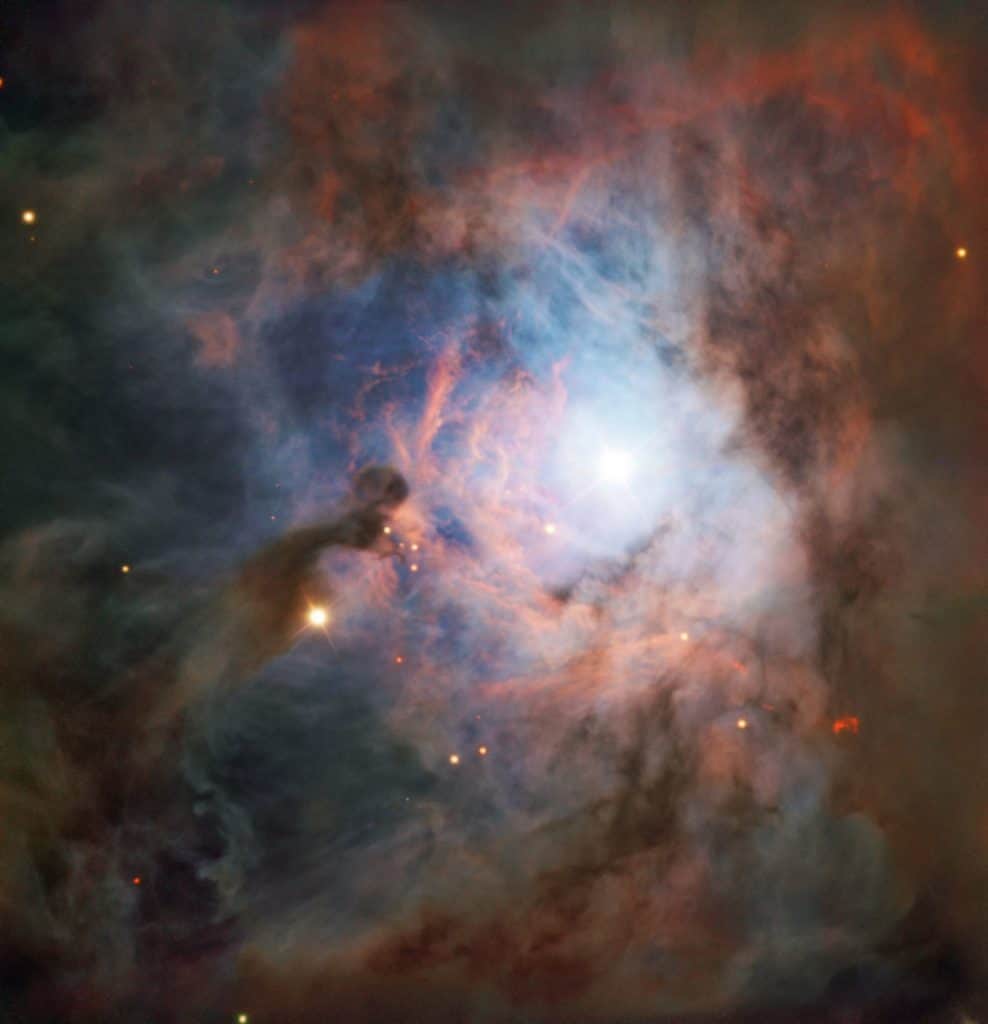
This nebula can be found a third of a degree from the Horsehead Nebula. NGC 2023 is around 1,467 light-years away from Earth.
Monkey Head Nebula
The Monkey Head Nebula, designated as NGC 2174, is an emission nebula classified as an H II region. It is associated with the open cluster NGC 2175, also located in Orion.

The Monkey Head Nebula is around 6,400 light-years away from us. It has an apparent magnitude of 6.8. This nebula is believed to have formed through hierarchical collapse – the process by which dense regions within molecular clouds collapse and form stars.
Clusters
The 37 Cluster – NGC 2169
NGC 2169 is an open star cluster, located at around 3,600 light-years away. It has an apparent magnitude of 5.9. It is called the 37 cluster since it resembles the number 37.
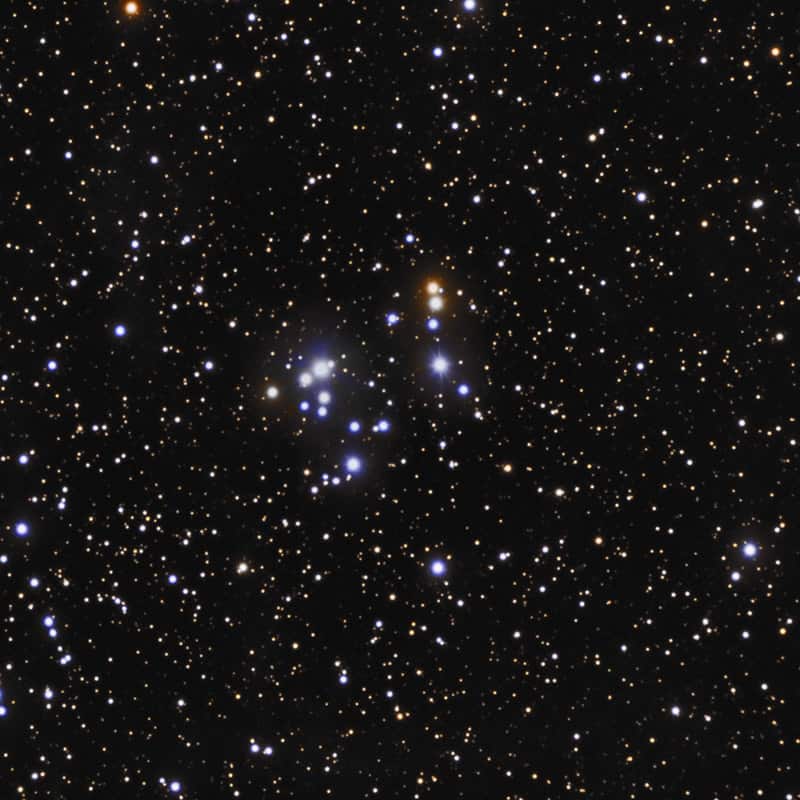
NGC 2169 is just under seven arc minutes in diameter and consists of around 30 young stars, which are around eight million years old. The brightest star here has an apparent magnitude of 6.94.
Orion Trapezium Cluster
The Trapezium is a young, tight open cluster situated in the middle of the Orion Nebula. It is 47 arcseconds in size, having an apparent magnitude of 4.0.
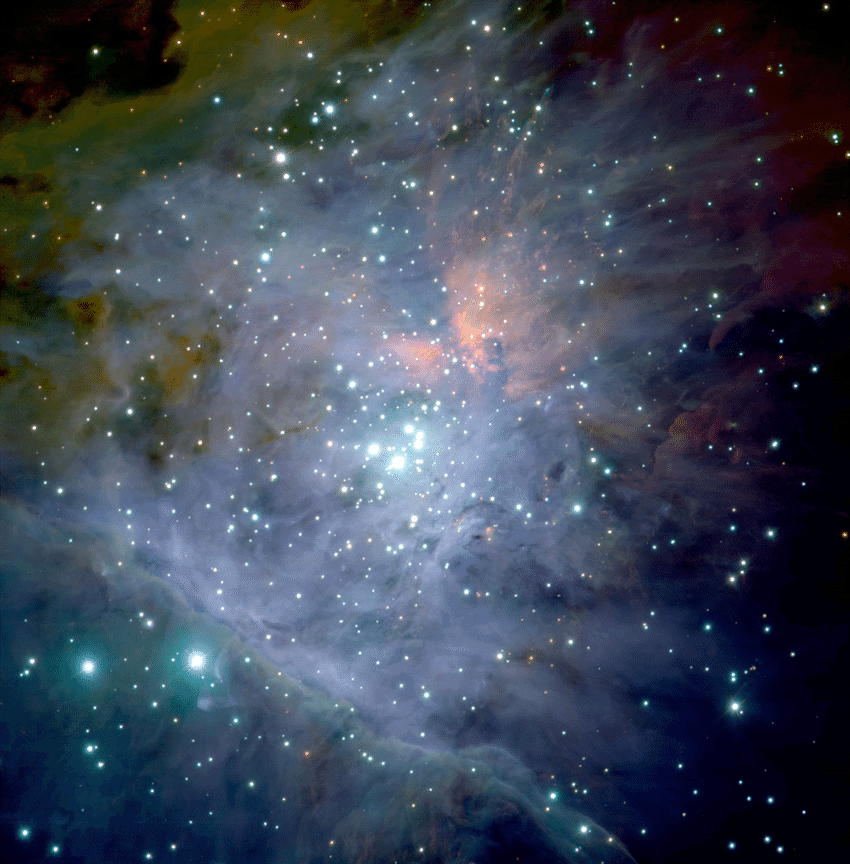
The cluster was first discovered by Galileo Galilei in 1617. Just five of the brightest stars in the Trapezium emit most of the light that illuminates the surrounding nebula.
The brightest star here, Theta-1 C Orionis, is a blue main-sequence star of spectral class O6pe V. It has an apparent magnitude of 5.13, and it is around 1,500 light-years away from us.
Orion Molecular Cloud Complex
The Orion Molecular Cloud Complex, or simply the Orion Complex, is comprised of a large group of dark clouds, bright emission and reflection nebulae, H II regions, and young stars.

The Orion Complex is between 1,500 and 1,600 light-years away from us. Many parts of it, such as the Orion Nebula, can be seen with the naked eye.
The Orion Molecular Cloud Complex contains the majority of the well-known deep sky objects in Orion – the Orion Nebula, Barnard’s Loop, the Flame Nebula, the Horsehead Nebula, Messier 43, and Messier 78.
Meteor Showers
The Orionid meteor shower reaches its peak around 20 October each year, and it's radiant appears to be the constellation of Orion. There are around 20 meteors per hour during this event, and the shower’s parent body appears to be Halley’s Comet.
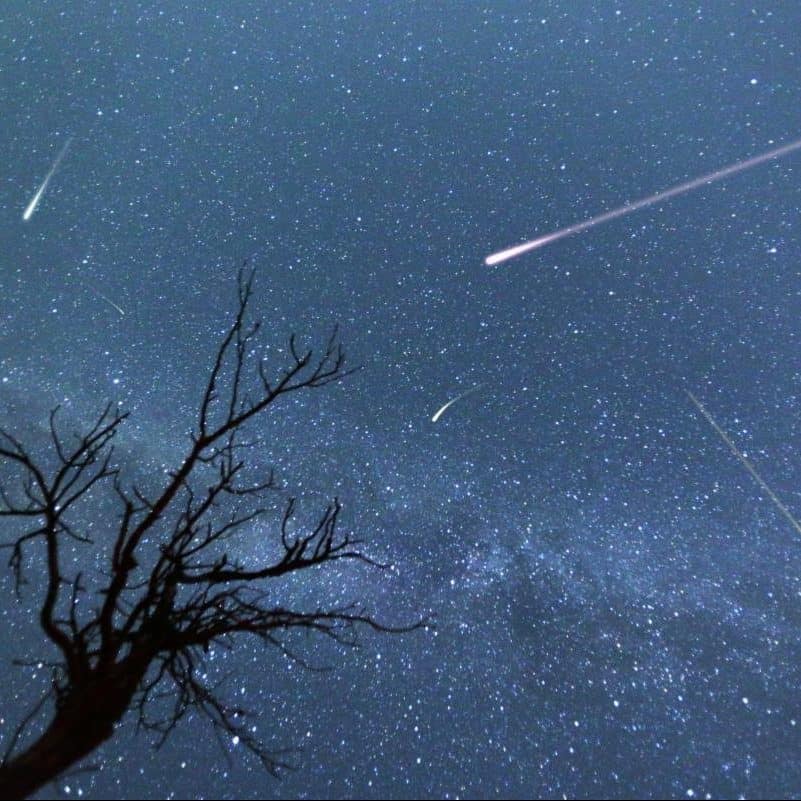
Mythology
In the Greek mythos, Orion was a giant supernaturally strong hunter, born to Euryale, a Gorgon, and Poseidon, the god of the sea. One myth recounts the Titan Gaia’s rage at Orion, who dared to say that he would kill every animal on Earth.
The angry goddess tried to dispatch Orion with a scorpion – this is given as the reason for why the constellations of Orion and Scorpius are never in the sky at the same time.
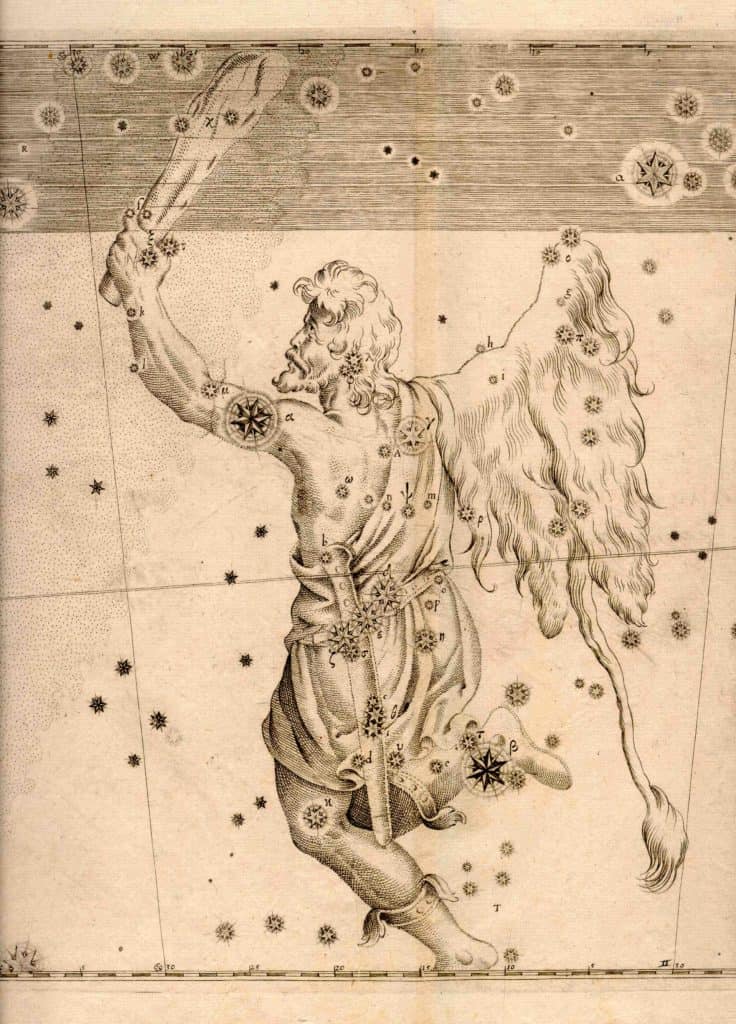
The scorpion managed to bite Orion but Ophiuchus, the Serpent Bearer, revived Orion with an antidote. This is said to be the reason for why the constellation of Ophiuchus stands midway between Scorpius and Orion in the sky.
The Future
Though the constellation of Orion is located on the celestial equator, it will not always lie there due to the effects of the Earth’s axis. Orion lies south of the ecliptic, it only happens to lie on the celestial equator because the point on the ecliptic that corresponds to the June solstice is close to the border of Gemini and Taurus, to the north of Orion.
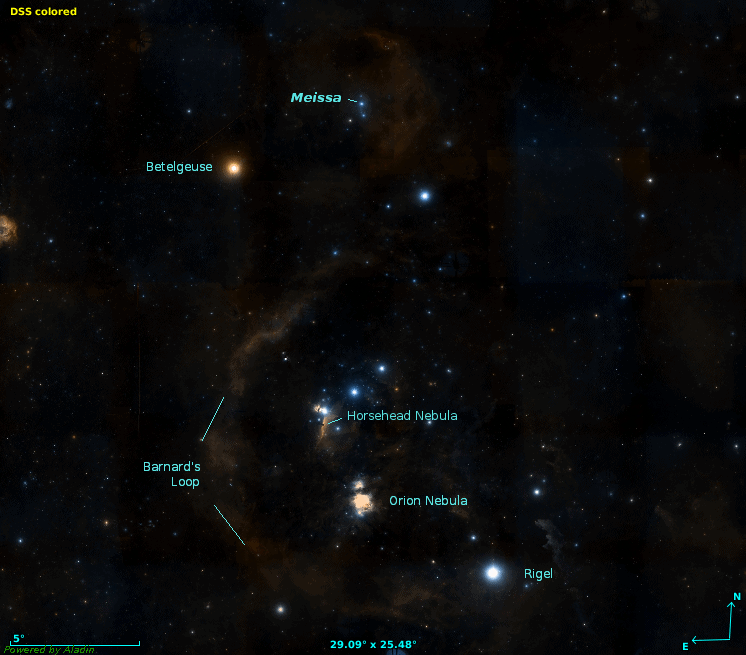
Precession will slowly carry Orion further south, and by AD 14,000, Orion will be so far south that it will become invisible from the latitude of Great Britain.
Did you know?
- In ancient Aramea, the offspring of the “sons of God” – the Nephilim – were said to be Orion’s descendants.
- In medieval Muslim astronomy, Orion was known as al-Jabbar – “the giant”.
- The Chinese view Orion as one of the 28 lunar mansions. Orion is known as Shen.
- In India, the cosmic dancer – Nataraja – is seen in the constellation of Orion.
- The Jain Symbol carved in Udayagiri and Khandagiri Caves, India – 1st century BCE, has a striking resemblance to Orion.
- In old Hungarian tradition, Orion is known as the “magic Archer”, he is called Nimrod.
- In Scandinavian tradition, Orion’s belt is known as Frigg’s Distaff – or Freya’s distaff.
Sources:
Image Sources:
- https://upload.wikimedia.org/wikipedia/commons/thumb/f/ff/Orion_IAU.svg/800px-Orion_IAU.svg.png
- https://cdn.pixabay.com/photo/2017/11/12/12/04/orion-2942260_960_720.jpg
- https://bobmoler.files.wordpress.com/2020/02/orion-and-dogs_2100-021720.png
- https://upload.wikimedia.org/wikipedia/commons/thumb/f/f3/Orion_Nebula_-_Hubble_2006_mosaic_18000.jpg/768px-Orion_Nebula_-_Hubble_2006_mosaic_18000.jpg
- https://upload.wikimedia.org/wikipedia/commons/thumb/f/f8/Messier_43_HST.jpg/471px-Messier_43_HST.jpg
- https://upload.wikimedia.org/wikipedia/commons/thumb/4/4a/Messier_78.jpg/792px-Messier_78.jpg
- https://steemitimages.com/p/2gsjgna1uruvUuS7ndh9YqVwYGPLVszbFLwwpAYXYcPSphnW8c7ZyWtz8RJYtEo5TFamp6pWX92FC89g3QCq7ojCfK4mq5VTuUc96QRn1GDgLDPf6W?format=match&mode=fit
- https://qph.fs.quoracdn.net/main-qimg-d445dd281cccd77027be65308e8382b5.webp
- https://50a8d2.medialib.edu.glogster.com/udNPiL04rl02Zj0X0F8f/media/3a/3a1669406cf288d8d548712202544baffeb3928d/rigel-and-sun.jpg
- https://i.pinimg.com/736x/f8/1c/24/f81c24a22b1c1e1e70ae1d40565939d9.jpg
- https://www.astronomytrek.com/wp-content/uploads/2017/07/Alnilam.jpg
- https://www.star-facts.com/wp-content/uploads/2019/09/Alnitak.jpg?189db0&189db0
- https://nineplanets.org/wp-content/uploads/2020/02/Saiph-Star.jpg
- https://www.nasa.gov/images/content/535941main_pia14040-full_full.jpg
- https://telescopeobserver.com/wp-content/uploads/2019/06/orion-stars.jpg
- https://upload.wikimedia.org/wikipedia/commons/thumb/4/4f/Orion_Belt.jpg/1200px-Orion_Belt.jpg
- https://upload.wikimedia.org/wikipedia/commons/thumb/9/9f/Orion-guide_dark.svg/220px-Orion-guide_dark.svg.png
- https://lh3.googleusercontent.com/proxy/FVMk9fdeGdwaImL60ln8nLrNSKeYtDCdzjmuvkTb8v9Eb4NUpTvZ33JTPF5stJ0n05Vp8tsogQsuFIV30wztJB6kqEwe6ScxyNpoSA1Z2818ytSDCGYkBq0F0Z4
- https://cdn.astrobin.com/thumbs/ye0p8ZxU2Fo9_1824x0_vdn5tupz.jpg
- https://img5.goodfon.com/wallpaper/nbig/1/7b/barnard-s-loop-sh-2-276-emission-nebula-nebula-constellation.jpg
- https://upload.wikimedia.org/wikipedia/commons/3/36/NASA-FlameNebula-NGC2024-20140507.jpg
- https://i.pinimg.com/originals/f6/a8/89/f6a8894f1b207df42c99ab1f19c38126.jpg
- https://cdn.spacetelescope.org/archives/images/screen/heic1406a.jpg
- https://www.cloudynights.com/uploads/monthly_03_2018/post-40734-0-09347300-1521571742.jpg
- https://www.researchgate.net/profile/A_Baudry/publication/308280341/figure/fig1/AS:408501902954496@1474405851133/The-Orion-Nebula-Trapezium-cluster-and-BN-KL-region-This-image-is-a-color-composite.png
- https://upload.wikimedia.org/wikipedia/commons/thumb/4/47/Orion_Head_to_Toe.jpg/1200px-Orion_Head_to_Toe.jpg
- https://lowell.edu/wp-content/uploads/2019/10/unnamed-11-e1571692886574.jpg
- https://upload.wikimedia.org/wikipedia/commons/4/49/Uranometria_orion.jpg
- https://astronomy.datapathways.com/images/astro/Meissa/Meissa-Aladin-DSS.png
